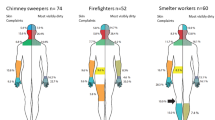Abstract
Purpose
The aim of this study was to create a job-exposure matrix (JEM) for wet work. A JEM is a tool used to assess exposure to potential health hazards in occupational epidemiological studies. It can be used when counselling concerning job change/job choice, as a medico-legal tool when recognizing diseases as occupational and when planning interventions regarding prevention of, in this case, occupational hand eczema.
Methods
The study population was based on results from national surveys on working environment performed by the National Research Centre for the Working Environment in Denmark in 2000, 2005, and 2010 (National Research Centre for the Working Environment). We assessed responses on questions regarding wet hands, glove wear and total wet work. For the JEM a cutoff of 2 h total wet work/day was chosen as the exposure measurement. The proportion of responses of 2 h total wet work/day in each profession is illustrated as a number between 0 and 1 equal to 0–100% of the responses.
Results
Total wet work was most frequent among cleaners (domestic, office, and hotel cleaning), butchers and fishmongers, cooks, beauticians (hairdressers, barbers, related work) and health care workers (home-based personal workers, dentists, dental assistants). Regarding differences between sexes we found that indifferent of age and profession, women had 78% higher odds of having wet work.
Conclusion
We found that wet work as an exposure varies among professions depending on whether wet hands or glove wear is assessed. A JEM is a useful tool to assess the extent of the exposure, wet work, independent of prior perceptions of classical wet work professions.

Similar content being viewed by others
References
Bryld LE, Hindsberger C, Kyvik KO et al (2003) Risk factors influencing the development of hand eczema in a population-based twin sample. Br J Dermatol 149:1214–1220
Carøe TK, Ebbehøj N, Agner T (2013) A survey of exposures related to recognized occupational contact dermatitis in Denmark in 2010. Contact Dermat 70:56–62
Carøe TK, Ebbehøj NE, Bonde JP, Agner T (2018) Occupational hand eczema and/or contact urticaria: factors associated with change of profession or not remaining in the workforce. Contact Dermat 78:55–63. https://doi.org/10.1111/cod.12869
Coenraads PJ, Diepgen TL (1998) Risk for hand eczema in employees with past or present atopic dermatitis. Int Arch Occup Environ Health 71:7–13
Coenraads PJ, Van Der Walle H, Thestrup-Pedersen K et al (2005) Construction and validation of a photographic guide for assessing severity of chronic hand dermatitis. Br J Dermatol 152:296–301. https://doi.org/10.1111/j.1365-2133.2004.06270.x
Dickel H, Kuss O, Schmidt A, Diepgen TL (2002) Importance of irritant contact dermatitis in occupational skin disease. Am J Clin Dermatol 3:283–289
Dickel H, Bruckner TM, Schmidt A, Diepgen TL (2003) Impact of atopic skin diathesis on occupational skin disease incidence in a working population. J Invest Dermatol 121:37–40. https://doi.org/10.1046/j.1523-1747.2003.12323.x
Diepgen TL, Coenraads PJ (1999) The epidemiology of occupational contact dermatitis. Int Arch Occup Environ Health 72:496–506
Diepgen TL, Andersen KE, Chosidow O et al (2015) Guidelines for diagnosis, prevention and treatment of hand eczema. J Dtsch Dermatol Ges 13:e1–e22
Flyvholm MA, Lindberg M (2006) OEESC-2005—summing up on the theme irritants and wet work. Contact Dermat 55:317–321
International Standard Classification of Occupations (1987) http://www.ilo.org/public/english/bureau/stat/isco/isco88/. Accessed 10 Feb 2019
Jungbauer FHW, Lensen GJ, Groothoff JW, Coenraads PJ (2004) Exposure of the hands to wet work in nurses. Contact Dermat 50:225–229
Lerbaek A, Kyvik KO, Mortensen J et al (2007) Heritability of hand eczema is not explained by comorbidity with atopic dermatitis. J Invest Dermatol 127:1632–1640
Meding B, Swanbeck G (1990) Predictive factors for hand eczema. Contact Dermat 23:154–161
Meding B, Lindahl G, Alderling M et al (2013) Is skin exposure to water mainly occupational or nonoccupational? A population-based study. Br J Dermatol 168:1281–1286
National Research Centre for the Working Environment. http://olddata.arbejdsmiljoforskning.dk/NationaleData/NAK2005/vejledning/metode.aspx?lang=da
Nilsson E (1986) Individual and environmental risk factors for hand eczema in hospital workers. Acta Derm Venereol Suppl (Stockh) 128:1–63
Skoet R, Olsen J, Mathiesen B et al (2004) A survey of occupational hand eczema in Denmark. Contact Dermat 51:159–166
Smith WG (2008) Does gender influence online survey participation? A record-linkage analysis of university faculty online survey response behavior. Eric Ed501717 1–21
Sørensen JA, Fisker MH, Agner T et al (2017) Associations between lifestyle factors and hand eczema severity: are tobacco smoking, obesity and stress significantly linked to eczema severity? Contact Dermat 76:138–145
Thyssen JP, Johansen JD, Linneberg A, Menné T (2010) The epidemiology of hand eczema in the general population—prevalence and main findings. Contact Dermat 62:75–87
Vindenes HK, Svanes C, Lygre SHL et al (2017) Prevalence of, and work-related risk factors for, hand eczema in a Norwegian general population (The HUNT Study). Contact Dermat 77:214–223
Funding
This study is independent research and funded by The Danish Working Environment Research Fund (Arbejdsmiljøforskningsfonden).
Author information
Authors and Affiliations
Corresponding author
Ethics declarations
Conflict of interest
The authors have nothing to declare.
Ethical approval
The study was approved by the Danish Data Protection Agency (Project Number BFH-2017-094). All methods were carried out in accordance with the relevant guidelines and regulations.
Additional information
Publisher's Note
Springer Nature remains neutral with regard to jurisdictional claims in published maps and institutional affiliations.
Electronic supplementary material
Below is the link to the electronic supplementary material.
Rights and permissions
About this article
Cite this article
Lund, T., Flachs, E.M., Sørensen, J.A. et al. A job-exposure matrix addressing hand exposure to wet work. Int Arch Occup Environ Health 92, 959–966 (2019). https://doi.org/10.1007/s00420-019-01435-2
Received:
Accepted:
Published:
Issue Date:
DOI: https://doi.org/10.1007/s00420-019-01435-2



